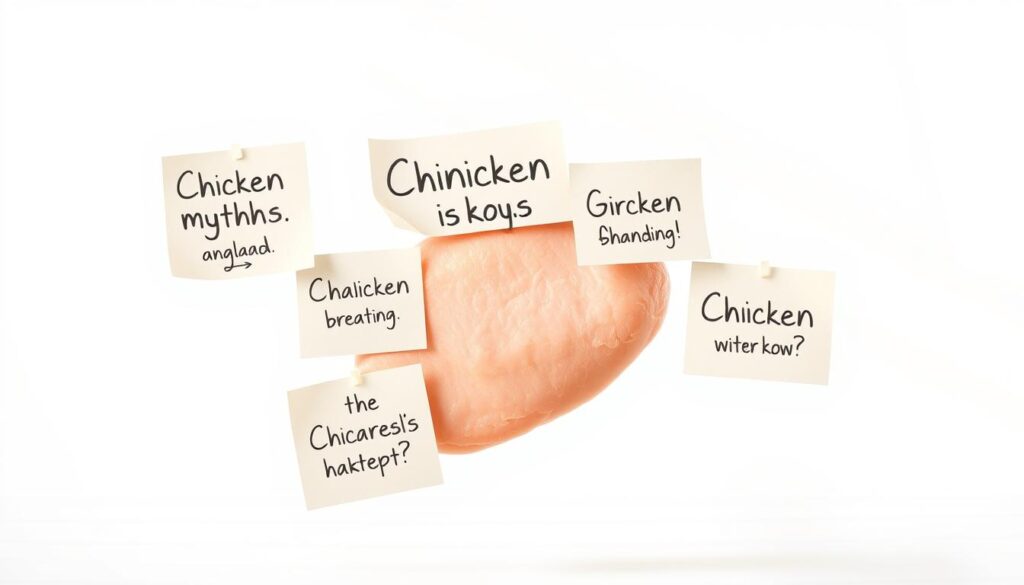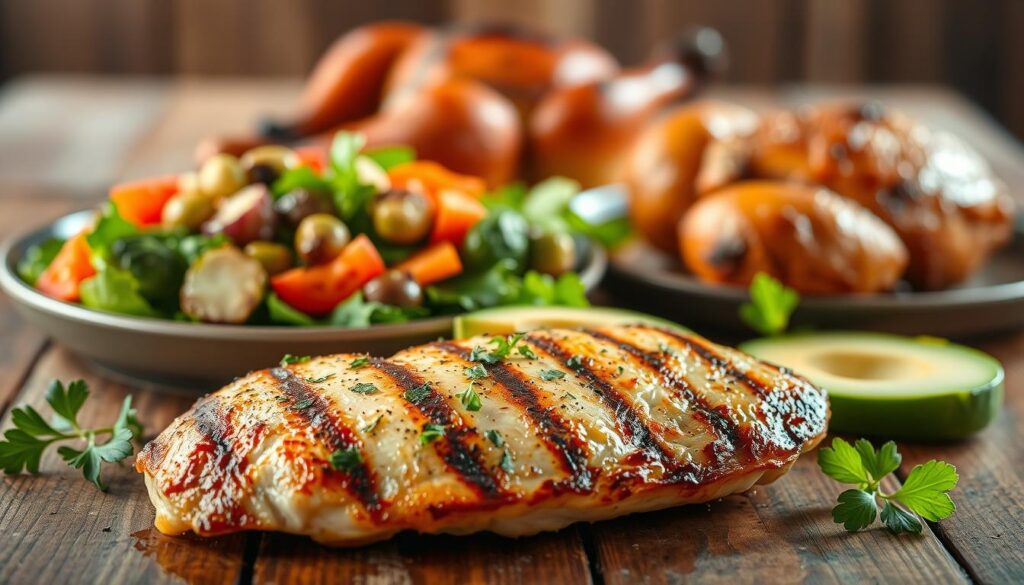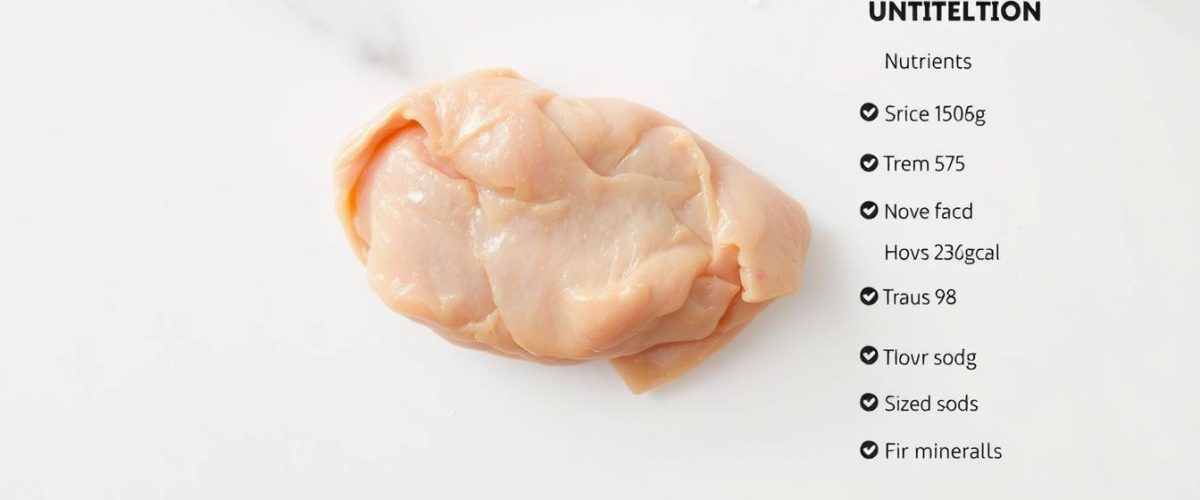Keeping a healthy diet means knowing about protein-rich foods. Chicken breast is a lean protein that’s lower in saturated fat than other bird parts.
Rich in protein and low in saturated fat, it’s good for your heart. It’s also very versatile, making it a favorite in many dishes.
Knowing its nutritional value helps you choose better foods. High in protein, it offers many health benefits. Adding it to your meals can make your diet healthier with chicken breast nutrition.
Nutritional Profile of Chicken Breast
chicken breast nutrition
Chicken breast is packed with nutrients, making it a great choice for your meals. It boosts your diet with essential vitamins and minerals.
Calories and Macronutrients
A 3.5-ounce serving of boneless, skinless chicken breast has about 160 calories. It also has 32 grams of protein. This is perfect for those wanting more protein without extra calories.
Chicken breast is full of protein, which is key for muscle growth and repair. It’s great for anyone who’s active or trying to lose weight.
Vitamins and Minerals
Chicken breast is not just high in protein but also in vitamins and minerals. It’s loaded with niacin, vitamin B6, and selenium. These nutrients help with energy, brain function, and fighting off cell damage.
Niacin turns carbs, fats, and proteins into energy. Vitamin B6 is important for the brain and making red blood cells. Selenium protects cells from harm. Eating chicken breast supports these important functions.
“Chicken breast is a nutrient-dense food that provides a range of essential vitamins and minerals, making it a valuable addition to a balanced diet.”
Health Benefits of chicken breast nutrition
chicken breast nutrition
Eating chicken breast regularly can greatly improve your health. It’s known for its many health benefits, making it a key part of many diets.
Lean Protein Source
Chicken breast is a great source of lean protein. This is important for staying healthy. It helps with building and fixing tissues, making enzymes, and hormones.
Being a lean protein, chicken breast helps grow muscles without extra fat. It’s perfect for those wanting to build muscle.
Muscle Growth and Repair
The protein in chicken breast is great for muscles. When you work out, your muscles get stressed and damaged. Eating chicken breast after working out helps fix and grow muscles.
Also, chicken breast has amino acids that help muscles recover. This is why athletes and fitness lovers often choose it.
Weight Management
Chicken breast is also good for weight management. It has a lot of protein but not many calories. This makes you feel full longer, helping you eat less.
It also boosts your metabolism because it takes more energy to digest than carbs or fat. Adding chicken breast to your meals can help you manage your weight well.
Cooking Methods and Their Nutritional Impact
Cooking methods are key to keeping chicken breast nutritious. The way you cook chicken can greatly affect its nutritional value. Some methods are healthier than others.
Grilling vs. Baking
Grilling and baking are healthier cooking options. Grilling uses direct heat, keeping nutrients in. It also locks in flavors and moisture. But, watch out for charring, as it can create harmful substances.
Baking is a dry-heat method that cooks evenly. It’s great for chicken breast, especially with herbs and spices instead of salt and sugar.
Frying and Its Effects on Nutrition
chicken breast nutrition
Frying involves cooking chicken in oil, increasing calories. It makes chicken taste good but affects nutrition. Frying can harm heart health due to unhealthy fats.
If you fry, use healthier oils like olive or avocado oil. Try to eat fried foods less often. Or, choose air frying for a crispy texture with less oil.
To get the most nutrition from chicken breast, choose grilling or baking. Be careful with ingredients. This way, you can have a healthy and tasty meal.
Chicken Breast and Heart Health
chicken breast nutrition
Heart health is key to feeling good overall. Adding chicken breast to your diet can help a lot. It’s a lean protein with nutrients that are good for your heart.
Low Saturated Fat Content
Chicken breast is great for your heart because it has low saturated fat content. Saturated fats can increase cholesterol, which is bad for your heart. Chicken breast is a better choice because it has less of these fats.
Choosing the right cooking method is also important. Grilling or baking chicken breast without the skin makes it even healthier.
Omega-3 and Omega-6 Fatty Acids
Chicken breast is not just lean protein; it also has omega-3 and omega-6 fatty acids. The amounts depend on the chicken’s diet and cooking method. These fats are good for your heart because they reduce inflammation and improve blood fats.
The balance between omega-6 and omega-3 fatty acids is crucial for heart health. Both are important, but a balanced mix helps prevent chronic diseases like heart disease.
Eating chicken breast can be a simple way to boost your heart health. It’s low in saturated fats and has essential fatty acids. This makes chicken breast a smart choice for better heart health.
Comparing Chicken Breast to Other Proteins
chicken breast nutrition
Have you ever wondered how chicken breast compares to other proteins? It’s key to know how different proteins stack up in terms of nutrition and health benefits. This knowledge helps you make better choices for your diet.
Chicken vs. Beef
Chicken breast and beef are both popular for their protein. But they differ in nutritional content. Chicken breast is leaner, with less fat and calories. Beef, however, has more iron and zinc, which are important minerals.
| Nutrient | Chicken Breast (3 oz) | Beef (3 oz) |
|---|---|---|
| Calories | 110 | 170-220 |
| Protein | 26g | 22-25g |
| Fat | 3g | 6-10g |
Chicken vs. Fish
Fish and chicken breast are both lean proteins. But fish has more omega-3 fatty acids, which are good for your heart and brain. Chicken breast, on the other hand, has more protein and B vitamins.
Chicken vs. Plant-Based Proteins
If you follow a plant-based diet, it’s important to compare chicken breast to plant-based proteins like beans and tofu. Plant-based proteins are often lower in saturated fat and higher in fiber. But chicken breast has more protein and is a complete protein source, meaning it has all essential amino acids.
- Advantages of Chicken Breast: High protein content, complete protein source, versatile in recipes.
- Disadvantages of Chicken Breast: May be higher in saturated fat if not cooked properly, can be expensive depending on the source.
- Advantages of Plant-Based Proteins: Lower in saturated fat, higher in fiber, environmentally friendly.
- Disadvantages of Plant-Based Proteins: May require combining multiple sources to achieve a complete protein, can be lower in certain nutrients.
In conclusion, choosing between chicken breast and other proteins depends on your dietary needs and preferences. Knowing the nutritional profiles of different proteins helps you make informed diet choices.
Common Myths About Chicken Breast
chicken breast nutrition
Chicken breast is often misunderstood, with myths about its leanness and farming practices. You might think it’s too lean or worry about antibiotics in chicken farming. Let’s look at these myths and find out what’s true.
Is Chicken Breast Too Lean?
Some believe chicken breast is too lean, which could lead to an unbalanced diet. But, chicken breast is a great source of lean protein. It’s essential for building and repairing muscles. Plus, it’s low in saturated fat, making it good for your heart.
Let’s compare chicken breast to other proteins. Here’s a table showing their differences:
| Protein Source | Protein Content per 3 oz Serving | Saturated Fat Content per 3 oz Serving |
|---|---|---|
| Chicken Breast | 26.7 grams | 0.9 grams |
| Beef (Lean Cut) | 22.6 grams | 3.5 grams |
| Salmon | 20.2 grams | 1.1 grams |
Misconceptions About Antibiotics
Antibiotics in chicken farming are another concern. While some farms use antibiotics, many are now going antibiotic-free. Look for “Raised Without Antibiotics” labels to choose antibiotic-free chicken breast.
Regulatory bodies are also working to reduce antibiotic use in poultry. For example, the FDA has set guidelines for the judicious use of antibiotics in food animals.

chicken breast nutrition
Knowing the truth about these myths helps you make better choices about chicken breast. Whether it’s about its leanness or farming practices, chicken breast has a lot to offer.
Tips for Choosing Quality Chicken
chicken breast nutrition
To get the best chicken, it’s key to know the differences in how it’s made. You’ll see many labels when buying chicken. Each label tells you about the animal’s care, the environment, and the chicken’s health.
Organic vs. Conventional
Organic chicken is made without antibiotics, hormones, or pesticides. It’s fed organic food. This way is kinder to animals and better for the planet. Choosing organic chicken means less chemicals for you and supports green farming.
Conventional chicken might get antibiotics and hormones to grow faster. It’s cheaper and easy to find. But, it worries some about antibiotic resistance and animal treatment.
| Characteristics | Organic Chicken | Conventional Chicken |
|---|---|---|
| Use of Antibiotics | No | Yes |
| Feed | Organic feed | Conventional feed |
| Environmental Impact | Lower | Higher |
Free-Range vs. Cage-Free
Free-range and cage-free describe where chickens live. Free-range chickens go outside, which is better for them and the meat. Cage-free chickens don’t live in cages but might still be crowded indoors.
Knowing these labels helps you choose what you believe in and like to eat.
Think about the chickens’ welfare and your health and the planet when choosing. Choosing better chicken supports good farming.
Portion Sizes and Serving Suggestions
chicken breast nutrition
Knowing the right portion sizes for chicken breast is key for a balanced diet. Eating the right amount helps you get the most nutritional benefits without too many calories.
Recommended Serving Size
The serving size for chicken breast changes based on your age, sex, and how active you are. Usually, a serving is about 3 ounces, which is like the size of a deck of cards.
Here’s a simple guide to help you:
| Activity Level | Recommended Serving Size |
|---|---|
| Sedentary | 3 ounces (85g) |
| Moderately Active | 4 ounces (115g) |
| Very Active | 5 ounces (140g) |
Eating Chicken in a Balanced Diet
Adding chicken breast to your diet is more than just watching portion sizes. It’s also about mixing it with other foods that are full of nutrients.
For a balanced meal, pair chicken breast with veggies, whole grains, and healthy fats. For example:
- Grilled chicken breast with roasted veggies and quinoa
- Chicken breast salad with mixed greens, avocado, and whole grain crackers
- Chicken breast stir-fry with brown rice and colorful veggies
By paying attention to portion sizes and mixing chicken breast into different meals, you can enjoy its health benefits while keeping your diet balanced.
Chicken Breast Recipes for Every Meal
chicken breast nutrition
Chicken breast is incredibly versatile. It’s perfect for any meal, from quick dinners to family favorites. It’s lean, protein-rich, and fits well in many cuisines.
Quick Weeknight Dinners
Busy evenings call for fast, healthy meals. Here are some quick dinner ideas with chicken breast:
- Grilled Chicken Breast with Roasted Vegetables
- Chicken Fajitas with Bell Peppers and Onions
- Chicken Breast Salad with Mixed Greens and a Citrus Vinaigrette
These meals are quick, flavorful, and nutritious. Grilled chicken breast is high in protein. Roasted veggies add fiber and vitamins.

chicken breast nutrition
Meal Prep Ideas
Meal prep saves time and ensures healthy eating. Chicken breast is ideal for prep due to its ease and versatility. Here are some ideas:
| Meal Prep Idea | Ingredients | Nutritional Highlights |
|---|---|---|
| Chicken and Rice Bowl | Chicken Breast, Brown Rice, Steamed Vegetables | High in Protein, Fiber, and Vitamins |
| Chicken Salad Jars | Chicken Breast, Mixed Greens, Cherry Tomatoes, Cucumber | Rich in Protein, Low in Calories |
| Chicken and Quinoa Wrap | Chicken Breast, Quinoa, Avocado, Lettuce | Good Source of Protein, Healthy Fats, and Complex Carbohydrates |
Family-Friendly Options
Cooking for the family can be tough. But, these chicken breast recipes are sure to please everyone. Here are some ideas:
- Chicken Parmesan with Pasta
- Chicken Tacos with Avocado Salsa
- Chicken and Broccoli Casserole
These dishes are tasty and balanced. They offer protein, veggies, and whole grains. You can customize them to fit your family’s tastes and dietary needs.
Special Dietary Considerations
chicken breast nutrition
Chicken breast is easy to add to your diet, whether you’re gluten-free or low-carb. It’s a versatile ingredient that fits many dietary needs. This makes it perfect for those with specific nutritional needs.
Gluten-Free Recipes
chicken breast nutrition
Chicken breast is great for gluten-free diets. You can make tasty gluten-free dishes with fresh herbs, spices, and gluten-free sauces. Here are some ideas:
- Grilled chicken breast with roasted vegetables
- Chicken breast salad with mixed greens, avocado, and gluten-free dressing
- Stuffed chicken breast with quinoa and vegetables, seasoned with herbs
When making gluten-free chicken recipes, make sure all ingredients are gluten-free. This prevents cross-contamination.
Low-Carb Options
chicken breast nutrition
Chicken breast is perfect for low-carb diets because it’s high in protein and low in carbs. You can make delicious low-carb dishes by pairing it with low-carb veggies and sauces. Some ideas include:
- Chicken breast with a creamy mushroom sauce and sautéed spinach
- Grilled chicken breast with a side of roasted broccoli and cauliflower
- Chicken Caesar salad without croutons, using a low-carb Caesar dressing
To keep your low-carb chicken recipes exciting, try different seasonings and marinades. Make sure they don’t have added sugars or high-carb ingredients.
Adding chicken breast to your gluten-free or low-carb diet lets you enjoy healthy, tasty meals. These meals meet your dietary needs.
Storing and Handling Chicken Breast Safely
chicken breast nutrition
Keeping chicken breast safe is key to avoiding foodborne illnesses. Knowing how to store and handle it is essential.
Refrigeration Techniques
Chicken breast must be stored at 40°F (4°C) or below. It’s important to use a covered container to avoid contamination.
Here are some tips for refrigerating chicken breast:
- Store chicken breast in a sealed container or zip-top bag.
- Keep it on the bottom shelf of the refrigerator to prevent juices from dripping onto other foods.
- Use it within a day or two of purchase.
Safe Cooking Temperatures
chicken breast nutrition
Cooking chicken breast to 165°F (74°C) is crucial to avoid illness. This ensures it’s safe to eat.
To cook chicken breast safely, follow these guidelines:
| Cooking Method | Temperature | Internal Temperature |
|---|---|---|
| Grilling | Medium-high heat | 165°F (74°C) |
| Baking | 375°F (190°C) | 165°F (74°C) |
| Pan-frying | Medium heat | 165°F (74°C) |
Always use a food thermometer to check the chicken breast’s internal temperature.
By following these guidelines, you can enjoy chicken breast safely. Remember, handling and storage are as important as cooking it right.
The Future of Chicken Breast Production
chicken breast nutrition
The way chicken breast is made is changing. This change is because people want more eco-friendly options. Your choices help shape this new direction.
Evolving Farming Practices
Sustainable chicken farming is gaining attention. It aims to better animal care, lessen environmental harm, and improve farming efficiency. By using these methods, farmers can reduce their impact on the planet without losing productivity.
Rise of Alternatives
Plant-based chicken alternatives are becoming popular. These products taste and feel like chicken but are plant-based. They cater to those who care about their health and the environment.
The future of chicken breast will blend sustainable farming and plant-based options. Expect to see more green and innovative products as the industry grows.



One Response